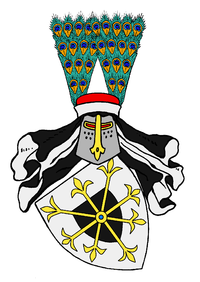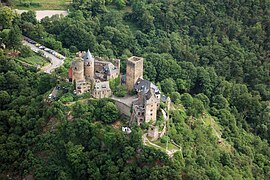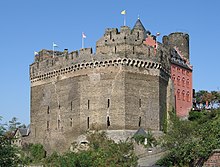Schönburg on Wesel
Schönburg auf Wesel , or Schönberg auf Wesel , formerly also Schonenberg , Schomberg or Schonburg , is the name of an old Rhenish noble family that rose from imperial ministerials to the gentry and at the beginning of the 17th century to the imperial count , a line was given the French in 1674 and soon afterwards the ducal dignity of England.
The ancestral seat was the Schönburg near Oberwesel on the Middle Rhine , built in the 12th century .
history
The family first appeared in documents with Otto von Schönburg in 1159. At the beginning of the 13th century an Otto von Schönburg can be proven.
In the 13th century, two families can be distinguished based on their coat of arms. The first had 6 labels (3: 2: 1), the second a central shield in the coat of arms. In the 16th century the family with the 6 little plates died out. Adam von Schöneberg, from the family with the middle shield, inherits property and coat of arms.
The Knights of Schönburg came to the Schönburg near Oberwesel, which was built in the first half of the 12th century, as administrative officials ( Reichsministeriale ) . The feudal lords changed: the archbishop of Magdeburg, the emperor and, from the 14th century, the archbishop of Trier. Since the middle of the 13th century, the family had branched out into different lines, all of which lived in the castle at the same time, as ownership passed through inheritance over the generations . No later than the 14th century, the plant for was Ganerbenburg with three separate living areas and three Bergfrieden expanded. A list of names from 1340 lists 95 co-owners of the castle, although not all of them lived in the castle. Like most castles in the Upper Middle Rhine Valley , the Schönburg was destroyed by the French in 1689 during the Palatinate War of Succession . The last Schönburger died in 1719; the ruin fell back to Kurtrier.
16th century: Friedrich the Elder becomes sole ruler
Adam von Schönburg auf Wesel was married to Guda von Wallbrunn . Her son was Friedrich the Elder from Schönburg on Wesel. His epitaph in the parish church in Oberwesel bears the inscription in Latin: "To Friedrich von Schönburg, the unique man with his cleverness and greatness of soul, who lived as the sole owner of the Schönburg over Wesel, which no one had managed for many years before him, partly because everyone The sons Friedrich and Meinhard had (this epitaph) built out of (filial) love. He died on February 21, 1550 at the age of 66 years. " The two sons mentioned come from his second marriage to Elisabeth von Langeln. He had married his first wife, Agnes von Dienheim, in 1509. She died in 1518. In the epitaph inscription it is emphasized that the great Schönburg belonged to Wesel Friedrich the Elder alone. He had profited from the extinction of other lines, and he had resigned his younger brother Johann. He had also released the existing pledges in order to come into sole possession of the castle.
One of the two sons was Friedrich the Younger from Schönburg on Wesel, who married Clara von Franckenstein , a daughter of Georg von Franckenstein († 1531) and Clara von Sternenfels .
From this marriage came Simon Rudolph von Schönburg auf Wesel (* 1551), whose epitaph is in the same church. The long inscription reports that Simon Rudolph died on January 16, 1608 at the age of 56 in the Luxembourg castle of Mont-Quintin. The transfer of the body to Oberwesel was done by his surviving widow, Magdalena von Naves († 1627), and their sons. Through Magdalena ( Madeleine ) von Naves, the von Schönburgs were connected to the influential Belgian- Luxembourgish family of Johann von Naves and came into joint ownership of the Luxembourg castles of Mont-Quintin, Montigny, Chinnery and Sancy .
The sons Otto Friedrich (* 1589; † 1631), Heinrich Eberhard (* 1590; † 1606), Johann Karl (* before 1591; † 1640) and Philipp Christoph (* before 1610) came from the marriage of Schönburg-Naves ; † 1612).
17th Century: Significance in the Thirty Years War

During the Thirty Years' War Otto Friedrich was an officer in the Catholic League and rose to become General Feldzeugmeister . After he besieged and captured Heidelberg with his regiment in 1622 , he took part in the battle of Stadtlohn in 1623 . In 1626 he was involved in the storming of Münden , the Mündener Blood Pentecost . After Tilly had proposed him as sergeant-general of the cavalry in that year , he was not appointed to succeed Pappenheim's imperial sergeant-general until 1631 . In 1629 he was employed in the Franconian Empire for the implementation of the Edict of Restitution . Only in 1631 did his riders leave this part of Franconia . Schoenburg troops also took part in the siege and destruction of Magdeburg . Otto Friedrich died in 1631 in the battle of Breitenfeld . The dead general was transferred to Leipzig and buried in what was then the Barefoot Church.
One of Otto Friedrich's nephews was Johann Eberhard Freiherr von Schönburg auf Wesel, a Bavarian colonel and commander of the Bavarian garrison in Auerbach . In June 1632 he was with 600 Croats over Hahnenbach in Koenigstein sunken and had ransacked the place and finally the city Pegnitz two Swedish regiments to free. A large part of the 13 companies , including three companies of Dragoons , were scattered to the wind, and some were captured. Shortly afterwards Johann Eberhard moved with all the troops that had arrived at Auerbach to Pottenstein in order to then take Bayreuth .
While Otto Friedrich's brother Heinrich Eberhard became provost of the Sankt Martin monastery in Oberwesel at a young age , but also died at the age of 16, Count Johann Karl von Schönburg took over the rule of Wesel (* before 1591, † 1640) and moved from the old gentry in the imperial count and continued the line of tribe . Count Johann Karl was imperial councilor and senior bailiff in Königstein . He died in Madrid in 1640 and was married twice. First with Anna Margareta von Cronberg († 1616), with whom he had the two sons Emanuel Maximilian Wilhelm and Johann Schweickard (* 1616; † 1617), who died as an infant. His second wife was Margareta Katharina Popel von Lobkowicz († Prague 1669). The older son Emanuel was named Count von Schönburg auf Wesel, Comte de Montigny, de Malatour, de Holle , was married to Magdalena Isabella Klara Eugenia von Cronberg († Luxembourg 1691) and died in 1682.
In 1717 Maria, heir daughter of the last Duke of Schomberg, married her relative Christoph Martin Graf von Degenfeld . Since then, the Degenfeld line has been given the name Degenfeld-Schonburg and the combined coat of arms.
The family should not be confused with the Counts and Princes of Schönburg (Saxon-Thuringian noble family ) and the Saxon von Schönberg (who also had a French line called Schomberg ).
Significant namesake
- Friedrich the Elder of Schönburg on Wesel (* 1484; † 1550), sole ruler of the Schönburg rule
- Meinhard von Schönberg (* 1530; † 1596), Electoral Palatinate field marshal and bailiff of Bacharach
- Hans Meinhard von Schönberg (* 1582; † 1616), Field Brister of the Electorate of the Palatinate and Brandenburg, and Court Master of Elector Friedrich V of the Palatinate
- Otto Friedrich von Schönburg auf Wesel (* 1589; † 1631), imperial baron , general field master
- Johann Karl von Schönburg auf Wesel (* before 1591; † 1640), imperial count , imperial councilor and senior bailiff in Königstein
- Johann Eberhard von Schönburg, imperial baron, colonel in the Thirty Years War, liberator of the Bavarian city of Pegnitz
- Count Friedrich von Schomberg (* 1615; † 1690), 1674 French Duke, 1675 Marshal of France , 1687 Brandenburg General and 1688 British General
- Duke Meinhard von Schomberg , Duke von Leinster, (* 1641; † 1719), German-French-British general and military leader
- Duke Karl von Schomberg (* 1645; † 1693) was a German-born general in the service of various gentlemen
Tomb of Meinhard von Schönberg (1530–1596), Field Marshal of the Electoral Palatinate
Count Friedrich von Schomberg (1615–1690), 1674 French Duke, 1675 Marshal of France, 1688 British General
Duke Meinhard von Schomberg , Duke von Leinster (1641–1719), German-French-British general
coat of arms
Family coat of arms : In silver, a black heart shield , over the whole thing a golden Glevenwheel , covered with a blue gemstone on the hub; on the helmet with black and silver blankets a red tournament hat with a white faceplate, in it two stacks of peacock feathers, later a dog sitting between two buffalo horns.
Individual evidence
- ↑ Bernd Warlich: The Thirty Years' War in personal testimonies, chronicles and reports - Otto Friedrich Freiherr von Schönburg auf Wesel (* 1589; † 1631)
- ↑ Bernd Warlich: The Thirty Years War in personal testimonies, chronicles and reports - Johann Eberhard Freiherr von Schönburg on Wesel
- ↑ a b Bernhard Peter: Schönburg on Wesel
- ^ Geneall.net: Johann Karl, Count of Schönburg on Wesel
literature
- Johann Siebmacher's heraldic books
- Sabrina Müller: The inscriptions of the Catholic parish church of our Dear Lady in Oberwesel , inscriptions Mittelrhein-Hunsrück, issue 1, ed. from the Academy of Sciences and Literature, Mainz, and the Institute for Historical Regional Studies at the University of Mainz e. V., Mainz 2008
- Otto Gruber: Coat of arms of the Middle Rhine-Moselle nobility , Trier 1962–1965, including addendum Trier 1967, also published in various volumes of the "Landeskundliche Vierteljahresblätter"
- Otto Gruber: The nobility ; in: Franz-Josef Heyen (Ed.): Between the Rhine and the Moselle. The St. Goar district . Boppard 1966, pp. 389-420
- Rolf Zobel: Book of Arms for the Middle Rhine and Moselle , 2007
- Herbert Stoyan: Adel-digital , WW-Person on CD, 10th edition 2007, Degener Verlag ISBN 978-3-7686-2515-9 (Genealogies)
Web links
- Bernhard Peter: Schönburg on Wesel
- Bernhard Peter: Epitaph of Friedrich von Schönburg on Wesel
- Bernhard Peter: Epitaph of Simon Rudolph von Schönburg on Wesel
- Bernd Warlich: The Thirty Years' War in personal testimonies, chronicles and reports - Johann Eberhard Freiherr von Schönburg auf Wesel, Bavarian colonel
- Bernd Warlich: The Thirty Years' War in personal testimonies, chronicles and reports - Otto Friedrich Freiherr von Schönburg auf Wesel (* 1589, † 1631), ligistic general field master ; Uncle of the previous one







